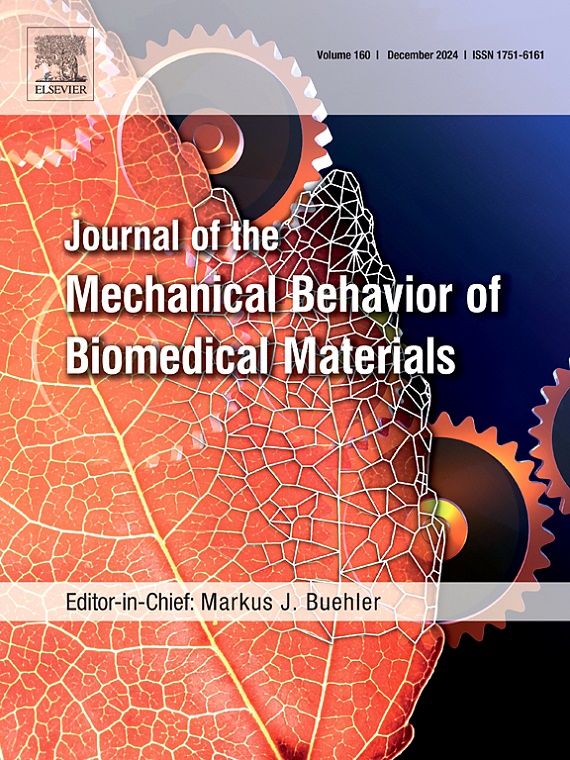Hybrid-manufactured silicon nitride coated CFR-PEKK: A candidate biomaterial for trauma plate applications?
IF 3.5
2区 医学
Q2 ENGINEERING, BIOMEDICAL
Journal of the Mechanical Behavior of Biomedical Materials
Pub Date : 2025-07-17
DOI:10.1016/j.jmbbm.2025.107141
引用次数: 0
Abstract
Continuous carbon fiber–reinforced polyetherketoneketone (CCF-PEKK) is a thermoplastic composite with properties suitable for trauma plate applications (elastic modulus, strength, radiolucency, and inertness). However, components manufactured by fused filament fabrication (FFF) often display non-uniform (anisotropic) mechanical properties and contain microstructural voids. To address these limitations, we investigated a hybrid-manufacturing approach, combining FFF with continuous carbon fiber reinforcement followed by uniaxial compression molding. Here, we asked: 1. Can layup orientation be tuned to replicate the mechanical stiffness of cortical bone in flexion? 2.) How does the structure of the different layups influence fracture behavior? and 3.) Do silicon nitride (Si3N4) (a bioactive ceramic with antimicrobial properties) embedded particulate coatings affect flexural or fracture behavior? To answer these research questions, we fabricated CCF-PEKK plates with three fiber layups (0°/90°, +45°/-45°, and 0°/90°/+45°/-45°) with the goal of approaching the flexural modulus of cortical bone (1.7–16.3 GPa). Next, half of the hybrid-specimens were spray-coated with submicron Si3N4 powder. Four-point bending tests demonstrated that fiber orientation significantly influenced flexural modulus and strength. The 0°/90° layup exhibited the highest flexural modulus (67.6 GPa) and strength (1020 MPa), while the +45°/-45° configuration showed the lowest values (15.6 GPa, 217 MPa), but displayed superior load dissipation in axial fiber orientations and was able to reproduce moduli values akin to those of cortical bone range. SEM analysis confirmed uniform Si3N4 coating distribution, with no observable impact on crack initiation or propagation. No difference (p > 0.01) in flexural modulus or strength was observed between the uncoated and coated specimens, suggesting that Si3N4 is not associated with static flexural properties of CCF-PEKK. These findings support the feasibility of hybrid-manufactured CCF-PEKK trauma plates as potential alternatives to conventional metallic implants. Further investigations into the long-term fatigue behavior and bioactivity of Si3N4 coatings are warranted.
混合制造氮化硅涂层CFR-PEKK:创伤钢板应用的候选生物材料?
连续碳纤维增强聚醚酮酮(CCF-PEKK)是一种热塑性复合材料,具有适用于创伤板应用的性能(弹性模量、强度、辐射率和惰性)。然而,通过熔丝制造(FFF)制造的部件通常表现出不均匀(各向异性)的力学性能,并含有微结构空洞。为了解决这些限制,我们研究了一种混合制造方法,将FFF与连续碳纤维增强相结合,然后进行单轴压缩成型。在这里,我们问:1。能否调整铺层方向以复制皮质骨屈曲时的机械刚度?2)。不同层位的结构对裂缝行为有何影响?和3)。氮化硅(Si3N4)(一种具有抗菌性能的生物活性陶瓷)嵌入颗粒涂层会影响弯曲或断裂行为吗?为了回答这些研究问题,我们制作了三种纤维层(0°/90°,+45°/-45°和0°/90°/+45°/-45°)的CCF-PEKK板,目标是接近皮质骨的弯曲模量(1.7-16.3 GPa)。接下来,将一半的杂交标本喷涂亚微米氮化硅粉末。四点弯曲试验表明,纤维取向对弯曲模量和强度有显著影响。0°/90°布局具有最高的弯曲模量(67.6 GPa)和强度(1020 MPa),而+45°/-45°布局具有最低的弯曲模量(15.6 GPa, 217 MPa),但在轴向纤维方向上表现出优异的负载耗散,并且能够复制类似于皮质骨范围的模量值。SEM分析证实Si3N4涂层分布均匀,对裂纹萌生和扩展没有明显影响。没有差别(p >;0.01),表明Si3N4与CCF-PEKK的静态弯曲性能无关。这些发现支持了混合制造的CCF-PEKK创伤钢板作为传统金属植入物的潜在替代品的可行性。进一步研究氮化硅涂层的长期疲劳行为和生物活性是有必要的。
本文章由计算机程序翻译,如有差异,请以英文原文为准。
求助全文
约1分钟内获得全文
求助全文
来源期刊

Journal of the Mechanical Behavior of Biomedical Materials
工程技术-材料科学:生物材料
CiteScore
7.20
自引率
7.70%
发文量
505
审稿时长
46 days
期刊介绍:
The Journal of the Mechanical Behavior of Biomedical Materials is concerned with the mechanical deformation, damage and failure under applied forces, of biological material (at the tissue, cellular and molecular levels) and of biomaterials, i.e. those materials which are designed to mimic or replace biological materials.
The primary focus of the journal is the synthesis of materials science, biology, and medical and dental science. Reports of fundamental scientific investigations are welcome, as are articles concerned with the practical application of materials in medical devices. Both experimental and theoretical work is of interest; theoretical papers will normally include comparison of predictions with experimental data, though we recognize that this may not always be appropriate. The journal also publishes technical notes concerned with emerging experimental or theoretical techniques, letters to the editor and, by invitation, review articles and papers describing existing techniques for the benefit of an interdisciplinary readership.
 求助内容:
求助内容: 应助结果提醒方式:
应助结果提醒方式:


